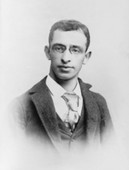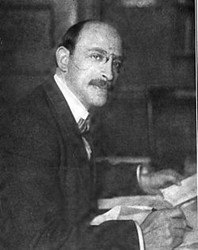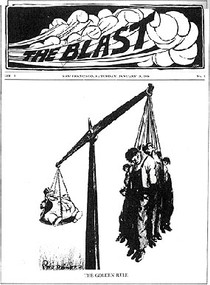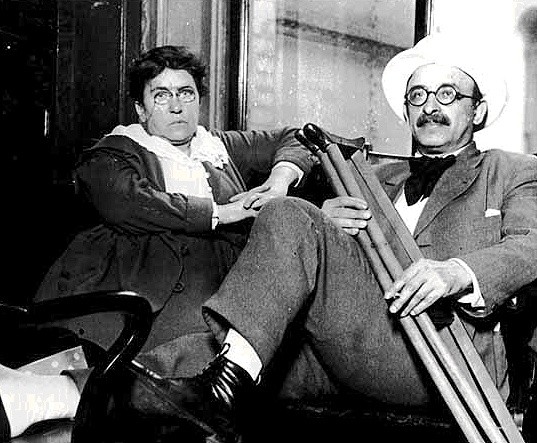Alexander Berkman’s home and office
Introduction
Text-to-speech Audio
Images
Photo courtesy of Wikimedia Commons

Photo courtesy of Wikimedia Commons

Photo courtesy of Wikimedia Commons

Photo courtesy of Found SF

Backstory and Context
Text-to-speech Audio
Born in 1877 to an upper-middle-class Jewish merchant family, Ovsei Osipovich Berkman was the youngest of four children. Due to his family’s wealth, they were granted the right to move from a restricted Jewish settlement to Saint Petersburg where his father had business. While there, the Berkman family assimilated into the mainstream Russian middle class and Ovsei took the very Russian name of Alexander. He attended the gymnasium, where he received a classical education alongside Saint Petersburg’s elite. Berkman was entranced by the radical philosophies of populism and nihilism, and was very upset when his favorite uncle was sentenced to death for his revolutionary activities.
The assassination of Tsar Alexander II in 1881 brought an end to the middle class privileges of the Berkman family, as Tsar Alexander III ‘s public policy was autocratic and anti-Semitic. His father died when he was twelve, thursting the family into poverty and forcing them to move to the Jewish settlement of Kovno where his mother’s family lived. During this time, young Alexander’s grades began to falter as he spent more and more time reading the novels of Ivan Turgenev, as well as Nikolay Cheryshevsky’s 'What Is to Be Done?' (The anarcho-socialist sensibilities of the latter work particularly inspired Berkman his life). Berkman became actively involved in promoting radical literature and ideas at school, and eventually was expelled for stealing exams and bribing a handyman. In 1888, Berkman made his escape to New York City.
Berkman’s work on the Pioneers of Liberty’s campaign to free the anarchists convicted of the Haymarket bombing brought him into the anarchist fold. As the association was primarily Jewish, the Pioneers regularly participated in labor strikes in Jewish-staffed sweatshops and organized some of the garment industry’s first unions. It was during this time that Berkman met comrade anarchist Emma Goldman, who would become his on-again, off-again lover and lifelong friend. Both Berkman and Goldman eventually fell into the orbit of Johann Most, America’s foremost anarchist and proponent of attentat, or, “propaganda of the deed,” which are acts of violence against counter-revolutionary parties as a means to bring attention to the cause. Although Berkman eventually distanced himself from Most because he felt that no one person should have so much power within the anarchist movement, Berkman retained his commitment to the philosophy of attentat.
Berkman’s opportunity to express attentat came in the summer of 1892 following the Homestead Strike, in which nine workers and seven Pinkerton guards were killed due to a work stoppage caused by the failure of Carnegie Steel Company to come to terms with the Amalgamated Association of Iron and Steel Workers. Berkman, Goldman, and their comrade Fedya Aronstam, decided that plant manager Henry Clay Frick was the perfect candidate for attentat. The murder was to be a suicide mission, but Berkman’s first attempt, a bomb, failed due to poor design, and his second attempt, a shooting/stabbing, also failed. His attempt to blow up the subsequent police interrogation by chewing on a capsule of dynamite, thus killing himself and the police, failed as well. He was tried and found guilty on six counts, and was sentenced to 21 years in Pennsylvania’s Western Penitentiary. Upon his release, Berkman continued his anarchist lecture tours and writing, eventually serving as editor for Emma Goldman’s anarchist journal, Mother Earth. After finding himself implicated in New York’s Lexington Avenue Bombing, Berkman left New York for San Francisco.
In San Francisco, Berkman started his own periodical, The Blast journal. Unlike Mother Earth, The Blast was narrowly focused on radical labor issues, organizing, strikes, and national labor news. Although it was published for a mere 18 months, The Blast was second only to Mother Earth in its influence on American anarchists. Berkman’s tenure in San Francisco drew to a close with the July 22 Preparedness Day parade bombing in 1916. Berkman was investigated but ultimately dismissed as a suspect in the event, and he subsequently ran the defense fund for the labor organizers, Tom Mooney and Warren Billings, who were convicted but eventually pardoned. By December of 1917, Berkman had relocated himself and The Blast to New York.
Shortly after returning to New York, Berkman and Goldman began agitating against military conscription in the war effort, and questioned the right of the state to make war. These activities resulted in their imprisonment and subsequent deportation under charges outlined in the 1917 Espionage Act. Finding himself disillusioned with the Russian revolution and the totalitarian dictatorship of Lenin, Berkman made his way to France, where he wrote the anarchist classic Now and After: The ABC of Communist Anarchism in 1929. Berkman settled in Nice with his partner Emily Eckstein, and worked as a translator and editor to support himself. The agony of a health condition drove Berkman to attempt suicide a final time in 1936. He shot himself, but the bullet lodged in his spinal columnn, which paralyzed but did not kill him. Goldman rushed to his side, and Berkman succumbed the night after her arrival. Alexander Berkman passed away on July 23, 1936.
Sources
Berkman, Alexander, and Gene Fellner. Life of an Anarchist: The Alexander Berkman Reader. New York: Four Walls Eight Windows :, 1992. Print. Pateman, Barry, and Alexander Berkman.
The Blast: Complete Collection of the Incendiary San Francisco Bi-Monthly Anarchist Newspaper. Edinburgh, Scotland: AK, 2005. Print.Simkin, John. Alexander Berkman. Spartacus Educational. July 01, 2014. Accessed March 19, 2017. http://spartacus-educational.com/USAberkman.htm.
